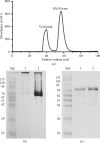Expression, purification, crystallization and preliminary crystallographic analysis of a GH20 β-N-acetylglucosaminidase from the marine bacterium Vibrio harveyi
- PMID: 25849504
- PMCID: PMC4388178
- DOI: 10.1107/S2053230X1500415X
Expression, purification, crystallization and preliminary crystallographic analysis of a GH20 β-N-acetylglucosaminidase from the marine bacterium Vibrio harveyi
Abstract
Vibrio harveyi β-N-acetylglucosaminidase (VhGlcNAcase) is a new member of the GH20 glycoside hydrolase family responsible for the complete degradation of chitin fragments, with N-acetylglucosamine (GlcNAc) monomers as the final products. In this study, the crystallization and preliminary crystallographic data of wild-type VhGlcNAcase and its catalytically inactive mutant D437A in the absence and the presence of substrate are reported. Crystals of wild-type VhGlcNAcase were grown in 0.1 M sodium acetate pH 4.6, 1.4 M sodium malonate, while crystals of the D437A mutant were obtained in 0.1 M bis-tris pH 7.5, 0.1 M sodium acetate, 20% PEG 3350. X-ray data from the wild-type and the mutant crystals were collected at a synchrotron-radiation light source and were complete to a resolution of 2.5 Å. All crystals were composed of the same type of dimer, with the substrate N,N'-diacetylglucosamine (GlcNAc₂ or diNAG) used for soaking was cleaved by the active enzyme, leaving only a single GlcNAc molecule bound to the protein.
Keywords: GH20 glycoside hydrolase family; Vibrio harveyi; β-N-acetylglucosaminidase.
Figures





Similar articles
-
Structural basis of chitin utilization by a GH20 β-N-acetylglucosaminidase from Vibrio campbellii strain ATCC BAA-1116.Acta Crystallogr D Struct Biol. 2021 May 1;77(Pt 5):674-689. doi: 10.1107/S2059798321002771. Epub 2021 Apr 27. Acta Crystallogr D Struct Biol. 2021. PMID: 33950022 Free PMC article.
-
Probing the Catalytic Mechanism of Vibrio harveyi GH20 β-N-Acetylglucosaminidase by Chemical Rescue.PLoS One. 2016 Feb 12;11(2):e0149228. doi: 10.1371/journal.pone.0149228. eCollection 2016. PLoS One. 2016. PMID: 26870945 Free PMC article.
-
Azide anions inhibit GH-18 endochitinase and GH-20 Exo β-N-acetylglucosaminidase from the marine bacterium Vibrio harveyi.J Biochem. 2016 Feb;159(2):191-200. doi: 10.1093/jb/mvv087. Epub 2015 Sep 1. J Biochem. 2016. PMID: 26330565 Free PMC article.
-
NAG-thiazoline is a potent inhibitor of the Vibrio campbellii GH20 β-N-Acetylglucosaminidase.FEBS J. 2020 Nov;287(22):4982-4995. doi: 10.1111/febs.15283. Epub 2020 Mar 23. FEBS J. 2020. PMID: 32145141
-
Potent inhibition of a GH20 exo-β-N-acetylglucosaminidase from marine Vibrio bacteria by reaction intermediate analogues.Int J Biol Macromol. 2018 Aug;115:1165-1173. doi: 10.1016/j.ijbiomac.2018.04.193. Epub 2018 May 3. Int J Biol Macromol. 2018. PMID: 29730005
Cited by
-
Structural basis of chitin utilization by a GH20 β-N-acetylglucosaminidase from Vibrio campbellii strain ATCC BAA-1116.Acta Crystallogr D Struct Biol. 2021 May 1;77(Pt 5):674-689. doi: 10.1107/S2059798321002771. Epub 2021 Apr 27. Acta Crystallogr D Struct Biol. 2021. PMID: 33950022 Free PMC article.
-
Structure and function of a novel periplasmic chitooligosaccharide-binding protein from marine Vibrio bacteria.J Biol Chem. 2018 Apr 6;293(14):5150-5159. doi: 10.1074/jbc.RA117.001012. Epub 2018 Feb 14. J Biol Chem. 2018. PMID: 29444825 Free PMC article.
-
Characterization of Stackebrandtia nassauensis GH 20 Beta-Hexosaminidase, a Versatile Biocatalyst for Chitobiose Degradation.Int J Mol Sci. 2019 Mar 12;20(5):1243. doi: 10.3390/ijms20051243. Int J Mol Sci. 2019. PMID: 30871033 Free PMC article.
References
-
- Actis, L. A., Tolmasky, M. E. & Crosa, J. H. (2011). Fish Diseases and Disorders, edited by P. T. K. Woo & D. W. Bruno, pp. 570–605. Wallingford: CABI.
-
- Armand, S., Tomita, H., Heyraud, A., Gey, C., Watanabe, T. & Henrissat, B. (1994). FEBS Lett. 343, 177–180. - PubMed
-
- Arndt, C., Koristka, S., Bartsch, H. & Bachmann, M. (2012). Methods Mol. Biol. 869, 49–53. - PubMed
-
- Austin, B. & Zhang, X.-H. (2006). Lett. Appl. Microbiol. 43, 119–124. - PubMed
Publication types
MeSH terms
Substances
LinkOut - more resources
Full Text Sources
Miscellaneous

